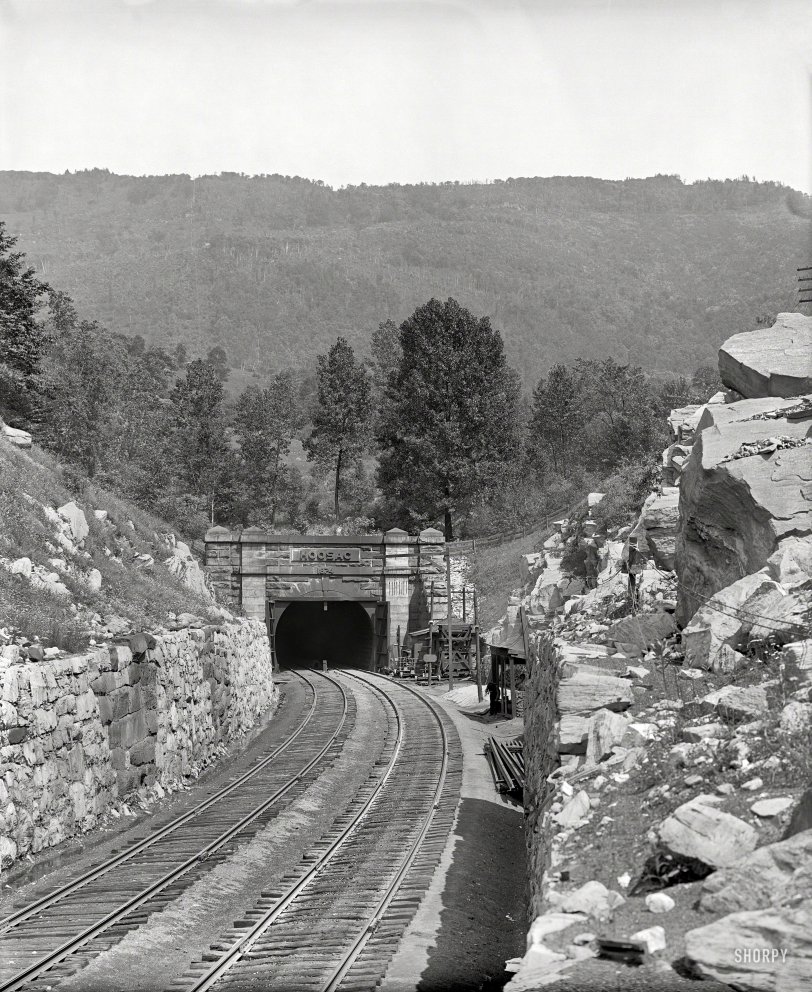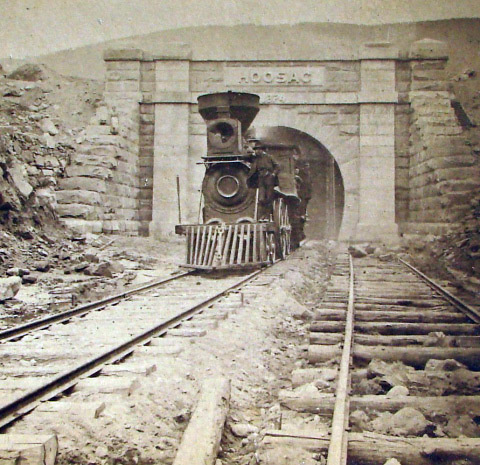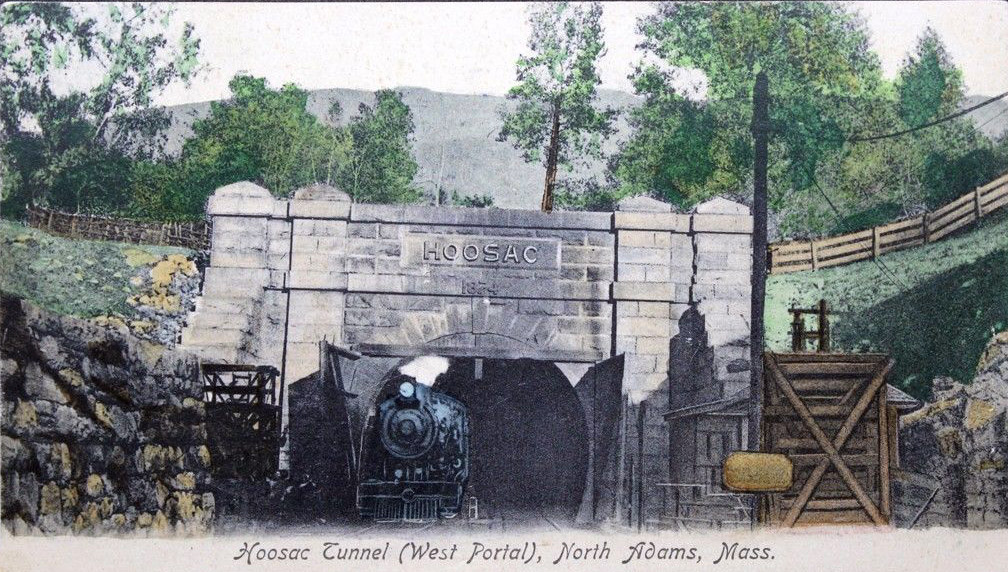


Framed or unframed, desk size to sofa size, printed by us in Arizona and Alabama since 2007. Explore now.
Shorpy is funded by you. Patreon contributors get an ad-free experience.
Learn more.

- Lost in Toyland
- And without gloves
- If I were a blindfolded time traveler
- Smoke Consumer Also Cooks
- Oh that stove!
- Possibly still there?
- What?!?
- $100 Reward
- Freeze Frame
- Texas Flyer wanted
- Just a Year Too Soon
- WWII -- Replacing men with women at the railroad crossing.
- Yes, Icing
- You kids drive me nuts!
- NOT An Easy Job
- I wonder
- Just add window boxes
- Icing Platform?
- Indiana Harbor Belt abides
- Freezing haze
- Corrections (for those who care)
- C&NW at Nelson
- Fallen Flags
- A dangerous job made worse
- Water Stop
- Passenger trains have right of way over freights?
- Coal
- Never ceases to amaze me.
- Still chuggin' (in model form)
- Great shot
Print Emporium
Hoosac Tunnel: 1907

Circa 1907. "West portal, Hoosac Tunnel, North Adams, Massachusetts." 8x10 inch dry plate glass negative, Detroit Publishing Company. View full size.
West Portal Door
This is the West Portal of one of my very favorite places, Hoosac Tunnel. East Portal is way prettier. The doors have something to do with keeping either water or snow out of the tunnel. I know the exact explanation is in the book "Pinprick of Light". The book also mentions failure of the brick lining on the west end due to (I believe) wetter conditions and far weaker rock (one reason why this end actually has a brick lining).
Being a responsible railfan, I must add that this is NOT an abandoned tunnel, and while current traffic tends to be later in the day/night, a train can come by at any time.

Electrification
Hoosac was electrified in 1910, and while Lost World is correct, Diesels did help, it did not totally do away with the problems crews faced. Wasn't until the late fifties that things were markedly improved.
The tunnel was electrified after a number of crews suffocated in the tunnel itself. It wasn't uncommon for crews to exit the tunnel lying on their stomachs in the cabs with cloths over their mouths and noses trying to get fresh air. Even in the early days of diesel locomotives, there was still an ever present danger of this. The Catenary didn't come down right away though, as the electrics were kept as backup until 1958 when the last one was finally scrapped. Even so, much of the catenary was still in place (just disued) until 1973 when the tunnel was made single track.
Hoosac Tunnel: 1907
About 16 years ago, I walked about 300 yards into the west portal. A fairly busy road passes only about a quarter mile from the entrance. Three or four times, I dashed out of the tunnel because I thought I heard a train coming, only to realize each time that I was hearing a truck go by. After about 15 minutes, I left, because not only was I pushing my luck regarding a train coming, but also because I was afraid I might startle an animal, such as a raccoon or a bear. I had my camera with me, so I decided to stand by the entrance, hoping that I might catch a shot of a train. I didn't have to wait more than three minutes. A train coming from the west (downtown North Adams) rumbled around the bend slowly and entered the tunnel, as I followed close behind, took a few pictures, and listened to the mysterious sound of the train gradually fading. Five miles later, it would see daylight again.
Switch on; then off
Overhead catenary wires for electric locomotives were added a few years after this photo. The electric motors would couple onto steam powered trains and pull them through the tunnel so the steamers wouldn't have to work, thus creating a lot of smoke to asphyxiate the engine crews. Even with ventilation shafts, tunnels were hellish in the steam age, and the Hoosac, almost five miles long, was one of the worst. Diesel power eliminated the need for electrics, and the wires were then removed.
Tunnel doors
EBT added doors to their tunnels after a locomotive derailed due to ice on rails in winter from ground water draining through tunnel. Doors were opened and closed by watchmen and later by engine crew.
Tunnel Doors
"In 1954 a steel storm door was installed on the West Portal replacing the wooden doors. These doors helped keep strange weather from entering the tunnel, particularly in the winter. In 1957 The tunnel was reduced to a single track 3 feet north of the center for clearance purposes. On November 28th 1958 passenger service stopped. In 1973 the track was centered and replaced by continuous welded rail. Finally in 1997 a 10 foot wide strip of stone was removed from The Tunnel’s ceiling and the track was lowered to allow for even taller railcars. The rail at the East Portal was sunk below ground level."
from A Pinprick Of Light by Carl R Byron and Hoosac Tunnel History

The west portal circa 1874
That Door
I think that the Garage Door Opener (& Closer) is partially sheltered in the nearest structure on the right. It looks like there might be a pair of bi-fold doors and a wood track for them overhead. The doors provide some protection from a "wind tunnel" effect that would allow cold winter air to defeat comparative warmth of being far underground. Nowadays, in conjunction with intake and exhaust fans above the Central Air Shaft, they can regulate which end of the tunnel gets ventilated and try to keep the smoke away from the engineers' eyes. Shortly after the Shorpy photo was taken, a short system of electric locomotives and wires was installed, to pull the steam trains through the mountain. The coal smoke had gotten so bad that someone passed a red Stop Signal without seeing it! Today, there are so few tracks and trains in the tunnel that it is hoped that the doors and fans can deal with the Diesel engine exhaust, and the electrics have been gone for 60 years or so.
Open and Shut
Why did they have doors on the entrance? That seems unusual for a railroad tunnel.
Where's the garage door opener?
Today the tunnel's west portal looks very different. What's essentially a very large garage door was added around 60 years ago, though I'm not sure why. The door's housing hides the "Hoosac" inscription seen in this picture. The tunnel also has had a single track for many years, not the double track as shown here.
One remaining drawback is that the tunnel doesn't have sufficient clearance to handle double-stack containers. There have been various engineering studies to see how that could be remedied, but the cost would be extremely high, and given that there's a more southerly route into Massachusetts with double-stack clearance it's doubtful anything will be done.


























On Shorpy:
Today’s Top 5